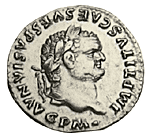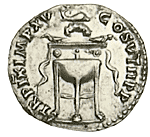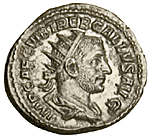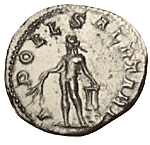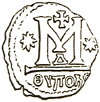
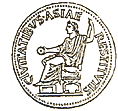

| Sestertius of Tiberius commemorating the restoration of Asian cities after the earthquake of AD 17 |
 |
|
||||||||
|
Having experienced personally the awesome power of nature's fury when the Northridge earthquake struck the Los Angeles area in January of 1994, I became interested in the mark left by such occurrences on the coinage of Imperial Rome. The Romans were great chroniclers of contemporary events on their currency, a function which is now more readily associated with the commemorative medal. The activities of the emperor in his varying roles as warrior, builder, and traveler received the most regular attention, but other happenings also had their place. These may not be obvious to the modern observer, as the numismatic reference usually focuses on the result of what took place rather than a commemoration of the natural event itself. But the allusion would most certainly not have been lost on those who lived through these disasters. An early example is to be found on a handsome brass sestertius type of Tiberius struck at Rome in AD 22-3. The historian Tacitus records that five years prior to the issue of this coin "Twelve famous cities of Asia were shaken by an earthquake at night . . . . . Sardis suffered most severely and attracted most sympathy accordingly. The Emperor promised 10 million sestertii and remitted all their liabilities to the senatorial and imperial treasuries for five years" (a better deal, I think, than the residents of Northridge received from Washington!). The coin shows a seated statue of Tiberius accompanied by an inscription celebrating his restoration of the Asian cities through the prompt relief measures his government had enacted (CIVITATIBVS ASIAE RESTITVTIS). We see here a glimpse of the compassionate policies of which the Roman Imperial administration was capable and doubtless followed far more frequently than the biased ancient commentators and their modern interpreters would have us believe. Four decades later another disaster affected the very heart of the Empire - the great fire which laid waste much of central Rome in July of AD 64, during the tenth year of Nero's reign. Whether justly or not the eccentric young emperor has been condemned by posterity as the author of this fearsome conflagration. He certainly took advantage of the opportunity to rebuild in the grand manner and, somewhat suspiciouly, his 'restoration' of the city concentrated on the construction and embellishment of the magnificent Domus Aurea,or 'Golden House'. This vast new imperial residence linked the palace on the Palatine with other imperial properties on the Esquiline. All of this activity was celebrated on extensive coin issues in gold, silver and brass featuring a representation of the goddess Roma. The elegant seated figure, based on earlier Greek images of Athena, personified the very spirit of the city which ruled the world and, thanks to her emperor, was now rising from the ashes in even greater glory than before. Nero also depicted his restored temple of Vesta on gold aurei and silver denarii. This famous structure, situated in the Roman Forum, was one of the most important casualties of the great fire of AD 64 and the emperor wasted no time in rebuilding it. The sixth structure to occupy the site, the Neronic temple was destined to survive for a century and a quarter until it too succumbed to a catastrophic fire late in the reign of Commodus. Few would argue that the eruption of Mount Vesuvius on August 23-24, AD 79, has created a deeper impression on the modern mind than any other natural disaster of antiquity. The disinterment of the towns of Pompeii and Herculaneum, and the spectacular nature of the finds revealed by archaeologists, have inspired writers and movie-makers to focus on the tragedy of the violent demise of these peaceful and prosperous communities. We may be sure that the event had a similar, or even deeper, effect on contemporary Romans, whose religious beliefs were steeped in superstition and the interpretation of omens. The disaster occurred only two months after Titus had succeeded to the imperial throne. He must have been extremely anxious that the gods were sending this sign of their displeasure at the very outset of his reign, and he may even have pondered on his destruction of the Temple in Jerusalem almost a decade before. Worse was to come, for in the following year (AD 80) Rome suffered an outbreak of plague followed by yet another devastating fire. All of this may have overwhelmed poor Titus who died prematurely in September of AD 81 at the age of only 42.
Much of the precious metal coinage of Titus' brief reign was devoted to depictions of a curious array of symbolic religious types. These commemorated the services of prayer and propitiation through which the emperor attempted to allay public alarm over these distressing events. Thrones were laid out in pairs for the gods and goddesses, each surmounted not by an image of the deity but by an emblem. These were displayed for the approval of the gods, representing an act of atonement, and by such means it was hoped that further catastrophes could be averted. Thus, we see types such as a seat or table surmounted by a thunderbolt (symbolizing Jupiter) or an ornamented diadem (Juno); a dolphin entwined around an anchor, representing Neptune; a tripod surmounted by a dolphin, signifying Apollo; and a curule chair surmounted by a wreath, recalling the divi, the deified former rulers of Rome, such as Augustus, Claudius, and Titus' own father, Vespasian. Similar types appeared on the coinage early in the reign of Titus' younger brother, Domitian. These probably refer to a further act of atonement in connection with the plague and fire of AD 80.
We now move on to the mid-3rd century. Rome's fortunes were in serious decline and her borders were threatened by ever-increasing numbers of barbarian nomads. The emperor Trajan Decius had been defeated and killed in battle against the Goths (AD 251) and his successor, Trebonianus Gallus, was obliged to conclude a shameful peace with the victors. An indirect result of this episode was a devastating outbreak of plague in Rome and the western provinces. The pestilence had been brought back by the returning Roman army, some members of which had been infected by the Goths with whom they had been in contact. The scourge was so serious and widespread that it even claimed the life of the co-emperor Hostilian. One of the coin types of Trebonianus Gallus appears to make specific reference to these events as it invokes the assistance of Apollo in his role as healer (Salutaris). This remarkable representation appears on the Roman coinage only at this time and the connection with the plague can hardly be seriously contested. To conclude this brief survey of the numismatic record of natural disasters we advance to a much later age, when Rome was no longer the imperial capital and most of the former western provinces had became barbarian kingdoms. The year was AD 528 and the emperor Justinian had recently succeeded his uncle Justin on the throne of Constantinople. On November 29th the celebrated city of Antioch, capital of Syria, founded more than 800 years before by the first of the Seleucid kings, was struck by an unusually powerful earthquake which reduced much of the place to rubble. So extensive was the necessary rebuilding that the decision was taken to cut the ties with the pagan past and to rename the city Theoupolis ("City of God"). Rare early issues of bronze coinage under Justinian bear the mint mark "ANTIX" and may be dated to the brief period August 527 to November 528. All subsequent issues from the mint have the mark "THEUP" or similar. Thus, a violent seismic event resulted in a change in name for one of the most famous cities of the Graeco-Roman world, an episode faithfully chronicled on the coinage of the early Byzantine state.
| ||||||||||||||




